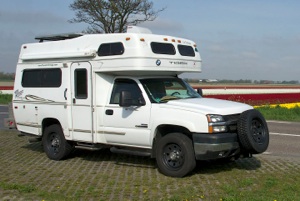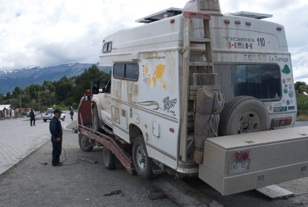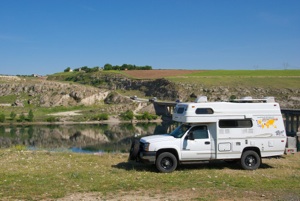
All in all we’ve been very fortunate and have experienced little in the way of problems with the vehicle. However, no vehicle can be perfect and we have had some issues along the way, ranging from minor annoyances to trip altering events. In this report, I’ll review the various repairs we’ve needed and try to pass along whatever hard won wisdom we’ve been able to accumulate both in terms of dealing with them enroute and perhaps avoiding them by better planning before the fact. I will break the information down into three areas: Our Chevrolet truck chassis, our Tiger living quarters, and the equipment or adaptations we’ve added to the original vehicle.
-
1. Chevy Truck:
We’ve always been very happy with the choice of our 2007 Silverado Classic 2500 HD truck and would not hesitate to go with a Chevy chassis again if we were buying a new Tiger today. The Duramax/Allison powertrain is excellent and we’ve been very happy with the overall handling, steering, braking, fuel economy, serviceability and comfort of the truck. That said, the most serious problems we’ve encountered with our vehicle have been Chevrolet problems, not Tiger problems, including the only times we’ve actually had to alter our trip plans in order to have something repaired. Our Chevy problems have occurred in two distinct areas; wheels and electronics, with a few odds and ends thrown in as well.
Wheels: Much to our surprise, we experienced two broken wheels on our truck after arriving in Europe in 2010 (this was at about 85,000 miles). These were the standard equipment steel wheels that came with the truck. The wheels cracked in the bead area, resulting in a creaking noise noticeable at low speed and a loss of air pressure. The tires didn’t go flat, but just lost some pressure; then when adding air, the pressure would leak out as it got above about 50 psi. When the first wheel broke, we had a spare wheel sent to us from the US (for our trip to South America we traveled with two spares but when coming to Europe we only brought one of them with us). Within a month, a second wheel failed in the same way.
We cannot say for sure what caused these wheels to fail, but can suggest three probable causes. First, our vehicle weight exceeds the GVWR of the truck by about 10%. This is pretty much impossible to avoid in most RVs. Our Tiger has an empty weight of 8800 lbs and the GVWR of our 2500 HD chassis is just 9200 lbs. Shortly after our unit was built, Tiger switched to the 3500 HD chassis, which has a higher GVWR, and in recent years GM has increased the weight ratings of all 2500 and 3500 chassis, so this problem should not occur on newer Chevys. Secondly, during our first 65,000 miles in the Tiger, which included time in Alaska, the Yukon, Mexico and Central and South America, roughly one third of all miles were traveled over unpaved or badly paved roads, including a lot of washboarding, particularly in South America. Lastly, in order to safely deal with the weight on the rear, we had upgraded our tires from 245x70 to 265x70 and were running the rear tires at their maximum pressure of 80 psi. This tire size is standard on the 3500 chassis, but I have never been able to ascertain whether the wheels on our 2500 HD were the same as on the 3500. I should also mention that to my knowledge, wheel breakage has never been a common problem with either Tigers or Chevy trucks, many of which carry heavy loads. I have always suspected that it was more the pounding of the washboard roads than the actual weight that caused the failure of the factory wheels.

We have now ordered the replacement wheels I would have bought in 2010 if I had known about them. The new units are Rickson 19.5” steel wheels that will carry a set of commercial truck tires. These wheels are rated at 5000 lbs each and I believe they will prove to be the final solution for us. Update July 2012: You can read about how they are working on our Tiger at our own Rickson Wheels page.
I’m sure that many, many owners of Chevy 2500 HD trucks carry as much weight as we do or even much more and have not had any problems with wheel breakage. Nonetheless, if I were buying a Tiger or mounting a conventional camper on a pre 2011 Chevy 2500, I would not stay with the stock wheels, but would replace them with a set of Rickson or other proven heavy duty wheels.
Due to the cracking of our wheels, we had to cancel our plans to go to Turkey in order to return to England where our resources for repairing the truck and for receiving shipments from the US are much better then in other parts of Europe. This was a sixteen hundred mile journey, with fuel costs as high as $8/gallon, in order to deal with a problem that should not have happened to begin with. Technically of course, this is not a Chevrolet problem at all. I’ve included it here because if the original factory wheels hadn’t failed we wouldn’t have needed to mount the Dick Cepek wheels. To close on a positive note, after some discussion and a few hoops to be jumped through, Mickey Thompson USA, the distributors of the Dick Cepek wheels, did give us a full refund of the entire purchase price of the failed wheels. Thank you MT!

May 2013 Update:
I am delighted to report that at long last we found someone who fixed our ongoing coding problem. In southern Turkey the problem got so bad we could no longer clear the code and continue driving. We went to the nearest Chevy Dealer and were lucky enough to find exactly what we needed, a service writer who spoke english and a young technician who was not intimidated by working on an American truck. The tech found a loose connection, of course, and they sent us on our way with no charge for the work. This was a month ago and we’ve been fine ever since. We are delighted!
Other Items: Beyond these two issues, we’ve had few problems with our Chevy. A dealer in Medellin, Colombia replaced an EGR motor under a Chevy recall and a dealer in Rapid City, South Dakota did the same with an exhaust flange and an axle seal (at 70,000 miles). We have continued to have leakage problems from the rear axle seals and have had repairs done on three separate occasions. The most recent repair, done in Batumi, Georgia on the shore of the Black Sea, seems to be holding. The two starting batteries failed after less than two years and were out of warranty because we were over 36,000 miles; that was rather disappointing. We again had to replace the starting batteries in March of 2012 so it seems they don’t last as long as we’d like. We also recently had to weld a crack in the frame over the rear axle. Several factors regarding our use of the truck and modifications we’ve made could have caused this and I don’t fault Chevrolet for it happening. As noted above, in 2011 GM fully re-engineered the 2500 and 3500 truck series with stronger, fully boxed frames and increased weight ratings so this is unlikely to happen on a newer truck.
Maintenance is simple and relatively infrequent; brakes, tires and other expendable items have lasted appropriate lengths of time, fuel economy is quite good, averaging about 14.5 mpg overall, but over 16 mpg on our recent highway run up to England running at 60-65 mph. Overall, the truck still starts, runs, and drives as it did when new. I will also say that the times we’ve needed help, the dealerships we’ve visited have been consistently good and Chevrolet was very fair in their handling of our warranty claim for the work done in Chile. We speak highly of our Chevy and particularly its Duramax/Allison power train whenever asked.
Update October 2012/April 2013: We’ve just experienced a front wheel bearing failure at 130,000 miles. While traveling in rural Turkey we stopped to have some noise checked and discovered the failed bearing. The bearings are sold only as an assembly with the front hubs and of course these parts could not be found in Turkey. One of the advantages of dealing with problems in less developed areas is that the mechanics are accustomed to having to make do; the hub was sent off to another shop where they pressed out the old bearing and pressed in a new one so that we could get back on the road. As anticipated at the time, this proved to be a temporary fix as the same bearing began making noise again within about 2,000 miles. When we flew back from the US this spring we carried two new hub assemblies in our checked luggage and had them installed right away. We should be good to go for some time now.
-
2.Provan Tiger:

The most serious issue we had to deal with early on was a water leak into the cabover bed area. This was present from the time we picked up the Tiger and wasn’t cured properly, despite three attempts by the factory, until two years later when we returned from South America. At that time, Provan was under new ownership and the new owner, Mark Guild, took great pains to discover the problem and get it fixed.
In 2009, after our trip to South America, we had a small list of things done to refit the Tiger prior to shipping it to Europe. For the most part these were either cosmetic items such as upgrading to the new kitchen counter top design and fitting new, firmer foam to the couch, or preventive measures such as new faucets and a new water pump that were done only in an attempt to prevent failures when we were once again out of the country. We also replaced the original mattress.
Now, in 2011, having discovered that there are several shops in England specializing in repairing and servicing American motorhomes, we are doing another round of minor RV house related repairs while we await delivery of our new wheels.
One issue that comes up as a question from time to time is whether the Tiger is a real expedition vehicle and whether or not the body will crack under heavy use. I can’t answer that for everyone, but I will say that we have experienced absolutely no stress cracks or any other sort of breakage of any part of the Tiger structure despite thousands of miles of unpaved, potholed, washboarded, muddy or just plain difficult roads. From Tierra del Fuego to the Andes to Morocco, Bulgaria and Turkey, the Tiger has held up very well for us in the way that we use it. We chose the Tiger because we want to be able to go down any road that we find, and we do. But we don't go off road other than into a field to park for the night. We don't go out of our way to find rough hills to climb or rocky escarpments to challenge; that’s just not what we do. Everyone’s idea of expedition is different. It may well be that some Tiger owners have subjected their units to more difficult conditions than we have and have encountered difficulties as a result. I can only comment on our own experience.
We bought our Tiger to travel the world, and as a travel vehicle it is fully up to any and all conditions we are brave enough to attempt. If Kathy and I see a dirt road and want to take it, we do. If it turns rougher or rockier or muddier than we are comfortable with we either decide to go on or we turn around or back out. Our goal when we bought the Tiger was to get a vehicle that will take us wherever we want to go, in all sorts of environments. This means a vehicle with enough traction and clearance to handle rough roads or bumpy fields that we want to camp in, but also one that is small and compact enough to take us into narrow medieval towns or Andean villages. It also means a vehicle that provides us with a comfortable home night in and night out for months and years at a time. For us, our Tiger meets that combination of challenges better than anything else we have seen before or since.
-
3.Add Ons:

Probably the next area for discussion is electronics, and we really haven’t had too many problems there. We have all of our solar work done by Ron at D&R Family RV in Glendale, Arizona, with the parts sourced through RV Solar Electric in Scottsdale. As a result of their good work we’ve experienced very little in the way of failures. The only things that come to mind are an inverter failure in Argentina and the recent failure of one of our solar panels. We had initially installed a much smaller inverter than we really wanted due to space limitations. When it failed, we went ahead and installed the full sized 2000 watt inverter we knew we needed, but we had to give up an entire closet shelf space to do it. More recently, one of our solar panels failed while we were in the Balkans. Working through RV Solar and then directly with Kyocera, the manufacturer, they shipped us a new panel all the way to Bulgaria, all under warranty. Excellent service all around.
As discussed above in the Chevy section, the failure of our Dick Cepek wheels really should come here in the add on area. This experience points out to us the limitations of relying entirely on internet research when looking for parts and accessories for your vehicle. Finding companies that give solid technical information on their products is difficult, and then sometimes the specs that are given turn out to be incorrect anyway. It’s a problem for all of us in this wired world; when traveling away from home it becomes more of an issue because the local dealer you’ve relied on for so long is no longer there to be asked. We have tried hard to maintain connections with people we’ve worked with along the way who seem knowledgeable and willing to help us when needed. Whether at home in the states or out on the road, such folks can be extremely valuable.
4. Conclusions:
We feel that we’ve done pretty well with our vehicle, traveling through more than fifty countries on five continents. The only spare parts we carry are filters and light bulbs. Each time we’re in the states I’ll ask at the Chevy dealer if we should be concerned about belts or hoses or other parts and they just smile and say no, although at this last request it was suggested that we replace the serpentine belt, which was done at 117,000 miles. We’ve always been able to have the truck serviced wherever we’ve been and have never had a bad service experience. When possible, mostly when we’re in the US, we’ll service the truck at a Chevrolet dealer, but we’ve also had work done at small shops in Costa Rica, Peru, Chile, Scotland, Morocco, Bulgaria, Turkey and even Georgia (the country, not the state) with never a problem.
Before we bought our Tiger we looked very hard at getting something based on the Mercedes Sprinter van, which is sold worldwide. While this could certainly be an advantage in the event of a major failure, we have found that we’re very comfortable going anywhere with our Chevy truck, finding service places along the way. To this point this has served us well and we have no regrets regarding our choice of vehicle.








